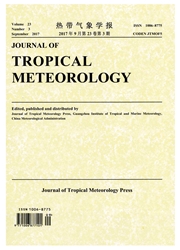

 中文摘要:
中文摘要:
基于最好轨道的数据和 JRA-25 分析,热带气旋(TC ) 的西方的向北和平的热带以外的转变(et ) 的气候学在这份报纸被介绍。它被发现那 35%(318 从 912 ) 所有, TC 在 1979 期间经历了 et - 2008。温暖季节(通过 9 月的 6 月) et 与大多数说明 64% 所有 et 事件在 9 月的出现。区域 120 楶祴搠湥楳祴眠獡挠潬敳祬挠牯敲慬整 ? 潴琠敨漠獢牥敶 ???捡畣畭慬楴敶爠楡普污 l
 英文摘要:
英文摘要:
Based on best-track data and JRA-25 reanalysis, a climatology of western North Pacific extratropical transition (ET) of tropical cyclone (TC) is presented in this paper. It was found that 35% (318 out of 912) of all TCs underwent ET during 1979 - 2008. The warm-season (June through September) ETs account for 64% of all ET events with the most occurrence in September. The area 120°E - 150°E and 20°N - 40°N is the most favorable region for ET onsets in western North Pacific. The TCs experiencing ET at latitudes 30°N - 40°N have the greatest intensity in contrast to those at other latitude bands. The distribution of ET onset locations shows obviously meridional migration in different seasons. A cyclone phase space (CPS) method was used to analyze the TC evolution during ET. Except for some cases of abnormal ET at relatively high latitudes, typical phase evolution paths--along which TC firstly showed thermal asymmetry and an upper-level cold core and then lost its low-level warm core--can be used to describe the main features of ET processes in western North Pacific. Some seasonal variations of ET evolution paths in CPS were also found at low latitudes south of 15°N, which suggests different ET onset mechanisms there. Further composite analysis concluded that warm-season ETs have generally two types of evolutions, but only one type in cold season (October through next May). The first type of warm-season ETs has less baroclinicity due to long distance between the TC and upper-level mid-latitude system. However, significant interactions between a mid-latitude upper-level trough and TC, which either approaches or is absorbed into the trough, and TC's relations with downstream and upstream upper-level jets, are the fingerprints for both a second type of warm-season ETs and almost all the cold-season ETs. For each type of ETs, detailed structural characteristics as well as precipitation distribution are illustrated by latitude.
 同期刊论文项目
同期刊论文项目
 同项目期刊论文
同项目期刊论文
 A statistical analysis on the different features of TC extratropical transition over land and ocean.
A statistical analysis on the different features of TC extratropical transition over land and ocean. Boundary Layer Structure in Typhoon SAOMAI (2006): Understanding the Effects of Exchanging Coefficie
Boundary Layer Structure in Typhoon SAOMAI (2006): Understanding the Effects of Exchanging Coefficie A Study on the Relationships between The Unusual Track of Typhoon MORAKOT(0908) and The Upper Wester
A Study on the Relationships between The Unusual Track of Typhoon MORAKOT(0908) and The Upper Wester Shear Gradient Vorticity Associated with TC Heavy Precipitation.: A High-resolution Numerical Extrat
Shear Gradient Vorticity Associated with TC Heavy Precipitation.: A High-resolution Numerical Extrat An observational study of environmental dynamical control of tropical cyclone intensity in the North
An observational study of environmental dynamical control of tropical cyclone intensity in the North BOUNDARY LAYER STRUCTURE IN TYPHOON SAOMAI (2006): UNDERSTANDING THE EFFECTS OF EXCHANGE COEFFICIENT
BOUNDARY LAYER STRUCTURE IN TYPHOON SAOMAI (2006): UNDERSTANDING THE EFFECTS OF EXCHANGE COEFFICIENT IMPACT OF UPPER-LEVEL COLD VORTEX ON THE RAPID INTENSITY AND MOTION CHANGES OF TYPHOON MERANTI (2010
IMPACT OF UPPER-LEVEL COLD VORTEX ON THE RAPID INTENSITY AND MOTION CHANGES OF TYPHOON MERANTI (2010 Intensity Change Characteristics of Tropical Cyclones in the Western North Pacific as Revealed by Th
Intensity Change Characteristics of Tropical Cyclones in the Western North Pacific as Revealed by Th Observational Analysis of Heavy Rainfall Mechanisms Associated with Severe Tropical Storm Bilis (200
Observational Analysis of Heavy Rainfall Mechanisms Associated with Severe Tropical Storm Bilis (200 THE RELATIONSHIP BETEEEN GLOBAL WARMING AND THE VARIATION IN TROPICAL CYCLONE FREQUENCY OVER THE WES
THE RELATIONSHIP BETEEEN GLOBAL WARMING AND THE VARIATION IN TROPICAL CYCLONE FREQUENCY OVER THE WES OBSERVATIONAL ANALYSIS OF ASYMMETRIC DISTRIBUTION OFCONVECTION ASSOCIATED WITH TROPICAL CYCLONES “CH
OBSERVATIONAL ANALYSIS OF ASYMMETRIC DISTRIBUTION OFCONVECTION ASSOCIATED WITH TROPICAL CYCLONES “CH Cyclone Phase Space Characteristics of the Extratropical Transitioning Tropical Cyclones over the We
Cyclone Phase Space Characteristics of the Extratropical Transitioning Tropical Cyclones over the We 期刊信息
期刊信息
